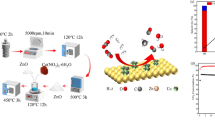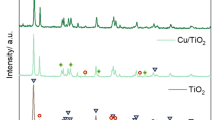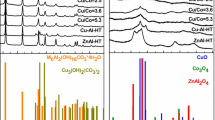Abstract
Catalytic conversion of the syngas into higher alcohols (HAs) via Fischer–Tropsch (F–T) synthesis is essential due to the widespread applications of HAs. The interfaces of cobalt and cobalt carbide (Co2C) are found to efficiently promote the HAs formation. However, the study on the links between structural evolution of Co–Co2C interfaces and HAs production is still lacking. In this work, Co3O4 with different contents of sodium (Na) as promoters was synthesized and high-pressure F–T reaction (3 MPa) was carried out in the aim of accelerating the Co2C formation and tuning the interfaces of Co–Co2C. XRD, (HR)TEM, ICP, XPS and XAFS were conducted to study the relationship between the variations of Co–Co2C interfaces and HAs production. With the increasing Na contents, the ratios of Co to Co2C decreased as revealed by XAFS and the selectivity of HAs was decreasing. The fitting results from EXAFS revealed that the ratio of Co to Co2C is in direct proportion to the selectivity of HAs. This work provides a theoretical guidance to tune the interfaces of Co–Co2C and improve the HAs production in F–T reaction.







Similar content being viewed by others
References:s
Colley SE, Copperthwaite RG, Hutchings GJ, Terblanche SP, Thackeray MM (1989) Identification of body-centred cubic cobalt and its importance in CO hydrogenation. Nature 339:129–130
Jenkins SJ, King DA (2000) A role for induced molecular polarization in catalytic promotion: CO coadsorbed with K on Co{101̄0}. J Am Chem Soc 122:10610–10614
Dry ME (2002) The Fischer–Tropsch process: 1950–2000. Catal Today 71:227–241
Cheng QP, Tian Y, Lyu SS, Zhao N, Ma K, Ding T, Jiang Z, Wang LH, Zhang J, Zheng LR, Gao F, Dong L, Tsubaki N, Li XG (2018) Confined small-sized cobalt catalysts stimulate carbon-chain growth reversely by modifying ASF law of Fischer–Tropsch synthesis. Nat Commun 9:3250
Yamane N, Wang Y, Li J, He YL, Zhang PP, Nguyen L, Tan L, Ai PP, Peng XB, Wang Y, Yang GH, Tsubaki N (2017) Building premium secondary reaction field with a miniaturized capsule catalyst to realize efficient synthesis of a liquid fuel directly from syngas. Catal Sci Technol 7:1996–2000
Li J, He YL, Tan L, Zhang PP, Peng XB, Oruganti A, Yang GH, Abe H, Wang Y, Tsubaki N (2018) Integrated tunable synthesis of liquid fuels via Fischer–Tropsch technology. Nat Catal 1:787–793
Peng XB, Cheng K, Kang JC, Gu B, Yu X, Zhang QH, Wang Y (2015) Impact of hydrogenolysis on the selectivity of the Fischer–Tropsch synthesis: diesel fuel production over mesoporous zeolite-Y-supported cobalt nanoparticles. Angew Chem Int Ed 54:4553–4556
Kang JC, Wang XJ, Peng XB, Yang YD, Cheng K, Zhang QH, Wang Y (2016) Mesoporous zeolite Y-supported Co nanoparticles as efficient Fischer–Tropsch catalysts for selective synthesis of diesel fuel. Ind Eng Chem Res 55:13008–13019
Galvis HMT, Bitter JH, Khare CB, Ruitenbeek M, Dugulan AI, de Jong KP (2012) Supported iron nanoparticles as catalysts for sustainable production of lower olefins. Science 335:835–838
Jiao F, Li JJ, Pan XL, **ao JP, Li HB, Ma H, Wei MM, Pan Y, Zhou ZY, Li MR, Miao S, Li J, Zhu YF, **ao D, He T, Yang JH, Qi F, Fu Q, Bao XH (2016) Selective conversion of syngas to light olefin. Science 351:1065–1068
Corma A, Melo FV, Sauvanaud L, Ortega F (2005) Light cracked naphtha processing: controlling chemistry for maximum propylene production. Catal Today 107–108:699–706
Zhong LS, Yu F, An YL, Zhao YH, Sun YH, Li ZJ, Lin LJ, Lin YJ, Qi XZ, Dai YY, Gu L, Hu JS, ** SF, Shen Q, Wang H (2016) Cobalt carbide nanoprisms for direct production of lower olefins from syngas. Nature 538:84–87
Subramani V, Gangwal SK (2008) A review of recent literature to search for an efficient catalytic process for the conversion of syngas to ethanol. Energy Fuels 22:814–839
**ao K, Bao ZH, Qi XZ, Wang XX, Zhong LS, Fang KG, Lin MG, Sun YH (2013) Advances in bifunctional catalysis for higher alcohol synthesis from syngas. Chin J Catal 34:116–129
Ao M, Pham GH, Sunarso J, Tade MO, Liu SM (2018) Active centers of catalysts for higher alcohol synthesis from syngas: a review. ACS Catal 8:7025–7050
Lin TJ, Qi XZ, Wang XX, **a L, Wang CQ, Yu F, Wang H, Li SG, Zhong LS, Sun YH (2019) Direct production of higher oxygenates by syngas conversion over a multifunctional catalyst. Angew Chem Int Ed 58:4627–4631
Cheng K, Zhou W, Kang JC, He S, Shi SL, Zhang QH, Pan Y, Wen W, Wang Y (2017) Bifunctional catalysts for one-step conversion of syngas into aromatics with excellent selectivity and stability. Chem 3:334–347
Yang JH, Pan XL, Jiao F, Lia J, Bao XH (2017) Direct conversion of syngas to aromatics. Chem Commun 53:11146–11149
Liao PY, Zhang C, Zhang LJ, Yang YZ, Zhong LS, Wang H, Sun YH (2018) Higher alcohol synthesis via syngas over CoMn catalysts derived from hydrotalcite-like precursor. Catal Today 311:56–64
Xu XD, Doesburg EBM, Scholten JJF (1987) Synthesis of higher alcohols from syngas recent patented catalysts and tentative on the mechanism. Catal Today 2:125–170
Zaman SF, Smith KJ (2012) A review of molybdenum catalysts for synthesis gas conversion to alcohols: catalysts, mechanisms and kinetics. Catal Rev Sci Eng 54:41–132
Pei YP, Liu JX, Zhao YH, Ding YJ, Liu T, Dong WD, Zhu HJ, Su HY, Yan L, Li JL, Li WX (2015) High alcohol synthesis via Fischer–Tropsch reaction at cobalt metal/carbide interface. ACS Catal 5:3620–3624
Zhao ZA, Lu W, Yang RO, Zhu HJ, Dong WD, Sun FF, Jiang Z, Lyu Y, Liu T, Du H, Ding YJ (2018) Insight into the formation of Co@Co2C catalysts for direct synthesis of higher alcohols and olefins from syngas. ACS Catal 8:228–241
Bahr H, Jessen V (1930) Die Kohlenoxyd-Spaltung am Kobalt. Ber Dtsch Chem Ges B 63:2226–2237
Yang YZ, Lin TJ, Qi XZ, Yu F, An YL, Li ZJ, Dai YY, Zhong LS, Wang H, Sun YH (2018) Direct synthesis of long-chain alcohols from syngas over CoMn catalysts. Appl Catal A General 549:179–187
Li ZJ, Zhong LS, Yu F, An YL, Dai YY, Yang YZ, Lin TJ, Li SG, Wang H, Gao P, Sun YH, He MY (2017) effects of sodium on the catalytic performance of comn catalysts for Fischer–Tropsch to olefin reactions. ACS Catal 7:3622–3631
Yu HS, Wei XJ, Li J, Gu SQ, Zhang S, Wang LH, Ma JY, Li LN, Gao Q, Si R, Sun FF, Wang Y, Song F, Xu HJ, Yu XH, Zou Y, Wang JQ, Jiang Z, Huang YY (2015) The XAFS beamline of SSRF. Nucl Sci Tech 26:050102
Ravel B, Newville M (2005) ATHENA, ARTEMIS, HEPHAESTUS: data analysis for X-ray absorption spectroscopy using IFEFIT. J Synchrotron Rad 12:537–541
He S, Wang W, Shen Z, Li GZ, Kang JC, Liu ZM, Wang GC, Zhang QH, Wang Y (2019) Carbon nanotube-supported bimetallic Cu–Fe catalysts for syngas conversion to higher alcohols. Molecular Catal 479:110610
Pena D, Griboval-Constant A, Lecocq V (2013) Influence of operating conditions in a continuously stirred tank reactor on the formation of carbon species on alumina supported cobalt Fischer–Tropsch catalysts. Catal Today 215:43–51
Park SJ, Bae JW, Lee YJ (2011) Deactivation behaviors of Pt or Ru promoted Co/P-Al2O3 catalysts during slurry-phase Fischer–Tropsch synthesis. Catal Commun 12(6):539–543
Height MJ, Howard JB, Tester JW (2005) Carbon nanotube formation and growth via particle-particle interaction. J Phys Chem B 109:12337–12346
Vander Wal RL, Ticich TM, Curtis VE (2001) Substrate-support interactions in metal-catalyzed carbon nanofiber growth. Carbon 39:2277–2289
Zhou W, Cheng K, Kang JC, Zhou C, Subramanian V, Zhang QH, Wang Y (2019) New horizon in C1 chemistry: breaking the selectivity limitation in transformation of syngas and hydrogenation of CO2 into hydrocarbon chemicals and fuels. Chem Soc Rev 48:3193–3228
Wu ZY, **an DC, Natoli CR, Marcelli A, Paris E, Mottana A (2001) Symmetry dependence of x-ray absorption near-edge structure at the metal KK edge of 3d3d transition metal compounds. Appl Phys Lett 79:1918–1920
Yang RO, **a ZM, Zhao ZA, Sun FF, Du XL, Yu HS, Gu SQ, Zhong LS, Zhao JT, Ding YJ, Jiang Z (2019) Characterization of CoMn catalyst by in situ X-ray absorption spectroscopy and wavelet analysis for Fischer–Tropsch to olefins reaction. J Energy Chem 32:118–123
Acknowledgements
We greatly appreciate the financial support from the Joint Fund (U1732267 and 9154101) of the National Natural Science Foundation of China (NSFC).
Author information
Authors and Affiliations
Corresponding authors
Ethics declarations
Conflict of interest
There are no conflicts to declare.
Additional information
Publisher's Note
Springer Nature remains neutral with regard to jurisdictional claims in published maps and institutional affiliations.
Electronic supplementary material
Below is the link to the electronic supplementary material.
Rights and permissions
About this article
Cite this article
Liu, Y., He, S., Yang, R. et al. Tuning the interfaces of Co–Co2C with sodium and its relation to the higher alcohol production in Fischer–Tropsch synthesis. J Mater Sci 55, 9037–9047 (2020). https://doi.org/10.1007/s10853-020-04612-8
Received:
Accepted:
Published:
Issue Date:
DOI: https://doi.org/10.1007/s10853-020-04612-8




